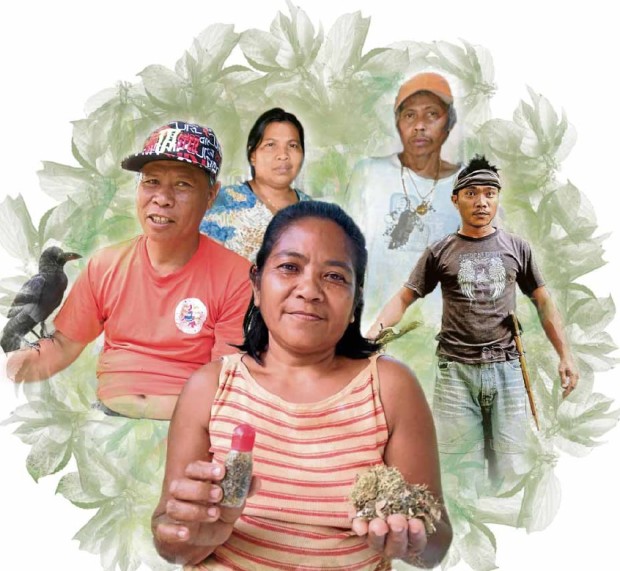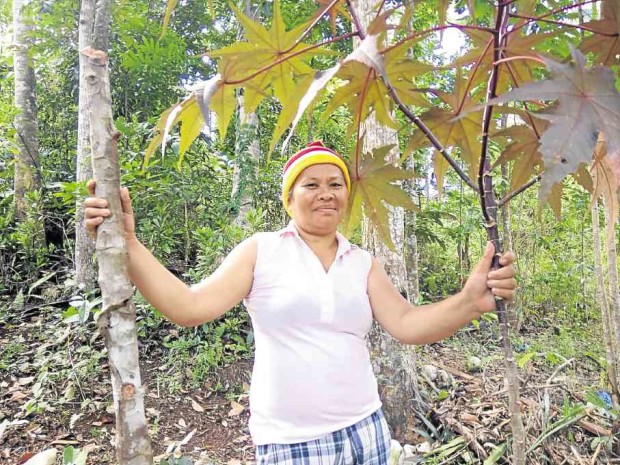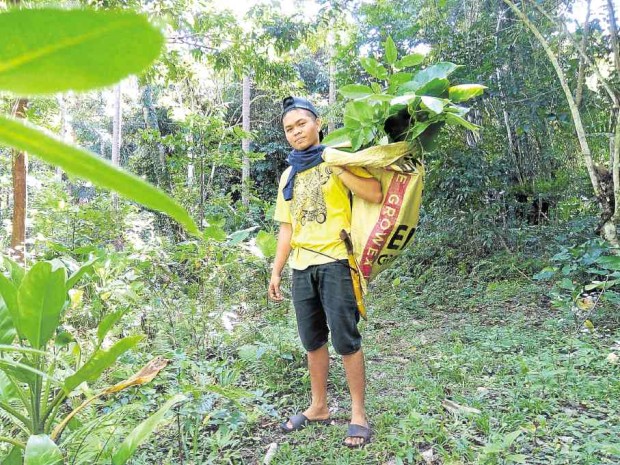The potions of Siquijor
SAN ANTONIO, Siquijor—Bienvenido Ponce had an early breakfast of rice, fish and coffee on March 24, a Friday. While sipping coffee, he instructed his youngest son, Christian, 12, to prepare a bolo and sack.
It was 8 a.m. and there was enough time for “tang-alap,” the 58-year-old healer said.
Tang-alap is the search in the forests for healing herbs for seven consecutive Fridays, which begins after Ash Wednesday and culminates on Good Friday and Black Saturday.
Ponce, his son Christian, his brother-in-law Eutellio, 49, and his two nephews—Jeffrey, 23 and Joseph, 34—walk for almost 3 kilometers each time, combing the relatively undisturbed forests and caves of Siquijor province.
“We must follow the process so as not to lose the potency of our medicines. We are following what our father taught us,” he said.
The process has to be precise.
On the first Friday, they went east and then west on the second Friday. On the third Friday, they went north.
For this trip, they headed south since it was the fourth Friday.
On the fifth Friday, they were back east. They gathered sea urchin, starfish, puffer fish and other sea creatures on the sixth Friday.
On the seventh Friday, they would visit old cemeteries to collect soil mixed with sand and bones of the dead.
Bienvenido said they have to collect at least 3,000 kinds of medicinal plants including those found in the sea.

For seven consecutive Fridays during Lent, healers scour Siquijor’s forest floor formedicinal herbs and other natural ingredients tomake potions and ointments.
Healing family
Bienvenido comes from a family of “mananambal” (healers) in Siquijor.
The knowledge came from a great grandfather.
Bienvenido said his grandfather, Ciriaco, trained his father, Juan, who passed on the art of healing to them. Juan died in 2011 at the age of 96.
It is not surprising that all of Juan’s six children—Alejandro, 64; Gabriel, 63; Virgilio, 62; Bienvenido; Diosdada, 56; and Romulo, 53—are healers who are also training their own children.
Some of the spouses are either herbalists, potion experts or amulet makers.
But the Ponces said they are not witches but herbalists who use medicinal plants to keep people healthy.
“Our father told us that every plant cures practically everything,” Diosdada said.
Some plants are a cure-all while others are for specific diseases.
“There are some herbs that grow in other areas but not as abundant as in Siquijor because healers from the Visayas and Mindanao come here to look for herbs,” Diosdada said.
Witchcraft, however, is also practiced in Siquijor, as legend would have it, especially in the village of San Antonio in the capital town.
Black and white
The mananambal are classified according to their intention—white if one wants to heal and black if the intent is to harm.
Sometimes, a mananambal who is well-versed in healing is also proficient in the dark arts.
They all recharge their “powers” during Holy Week.
Mananambal from the Visayas and Mindanao visit the mountain villages of Cantabon, Punong and San Antonio for the “pangalap.”
Some healers send their herbs by courier to fellow healers who can’t afford boat fare going to Siquijor.
“But it is really different if you come here and collect herbs yourself,” Bienvenido said.
On Good Friday, they would gather ingredients in making potions for the entire year. They start chopping and mixing these on Black Saturday.
The healers wait until the next Ash Wednesday before they start gathering the herbs.
At the Ponces’ residence on Black Saturday, Bienvenido becomes the elder of the family as they gather the ingredients.
They first make the “sumpa,” an antidote against “barang” (hexes), before the “pangadlip” or the chopping of the herbs for medicines.
Family members would pour into a large cauldron the “lana” (herbs and roots submerged in coconut oil), holy water, honey bee, “candelaria” (blessed candles) and herbs gathered during the Holy Week and had been burned. The ashes are collected and mixed.
Bad witch
Diosdada said only the “mambabarang” (black sorcerer) brews potions on Good Friday, the day Jesus Christ died on the cross.
But if the intention is to heal, they make potions on Black Saturday.
“The process of making potions is tied to the resurrection of Christ,” Bienvenido said.
“It’s a rebirth of power. That is why it is done during Holy Week,” he said.
After they finish with the sumpa, Bienvenido and his siblings would sit in a circle and chop each herb.
A mananambal will get a small amount of herbs and mix these with coconut oil or gin.
Since they are healers, the Ponces are sought to heal those who fall victims to mambabarang, who are often hired for vengeance and are still found in remote areas of the province.
A “barang” uses different methods. One effect supposedly makes insects come out of victims. “Paktol” uses a human skull and takes seven Fridays to complete. “Hapit” uses a wooden doll representing the victim. “La-ga” uses a victim’s personal items boiled in a pot supposedly to inflate the victim’s belly, cause sleeplessness, fatigue and even death. “Tunglo” is curse.
In 2006, the provincial government of Siquijor decided to hold an annual festival to ward off an image of Siquijor as home to witchcraft and promote it as a haven for healing.
Commercialization
During Holy Week, faith healers and herbalists, along with clients, climb Siquijor’s highest peak, Mt. Bandilaan, for the Healing Festival.
In stalls, patients or tourists consult them and buy amulets and potions for everything—from curing illnesses to improving sex life.
But other mananambal, like the Ponce family, except for Alejandro and his wife Anecita, refused to join the festival.
Diosdada said it’s a form
of commercialization that would defeat the purpose of healing—giving it free to those in need.
Commercialization also weakens healing powers, Bienvenido said.
The Ponces accept only donations from clients and sell products like lana, love potions and amulets, usually for P500.
Anacorita Fullido, Bohol-based sociologist, said gathering all the mananambal who have different styles in healing often leads to confusion and mixed results.
“They’re doing the rituals secretly and all of a sudden it becomes public,” Fullido said.
Msgr. Larry Catubig, parish priest of Our Lady of Good Providence Church in Maria town, said tang-alap is not bad because herbs are known to have healing properties.
But the rituals in making the potions, he added, are non-Christian.
Catubig said there is no such thing as barang, “lumay” or “anting-anting.” Instead, he said, people should believe in God and faith’s healing power.
RELATED VIDEO

















